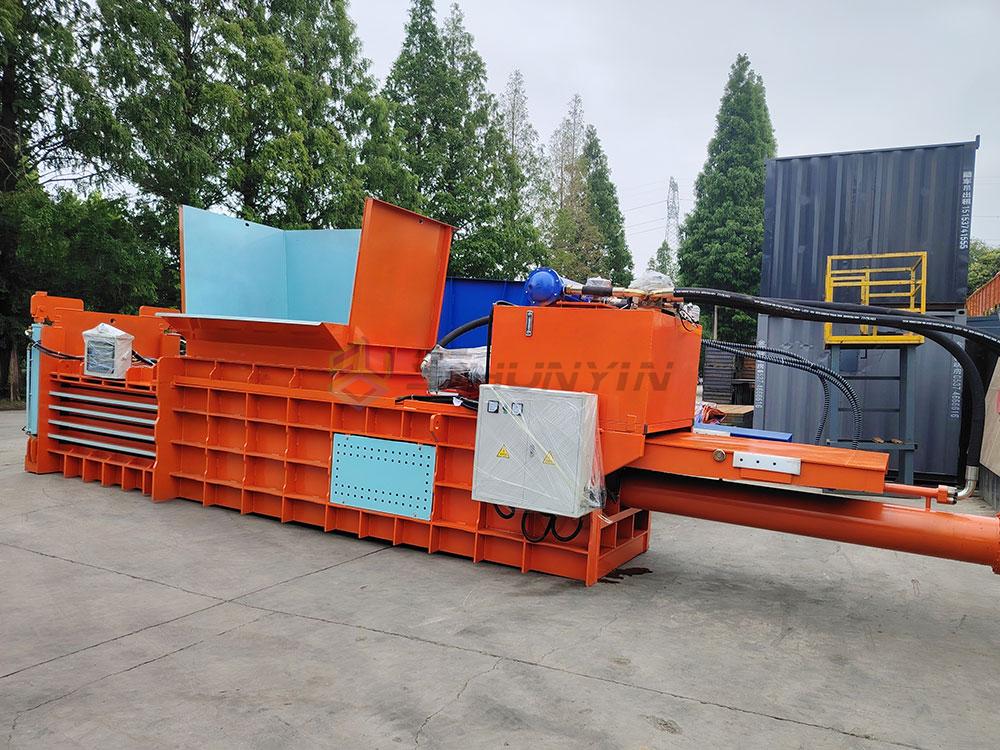Struggling with low-density paper bales? Waste compaction inefficiencies cut profitability. I design specialized solutions since 2009.
Our horizontal paper balers achieve 520kg/m³ density with adjustable compression plates and corner reinforcements – producing recycler-premium bales that increase value by 18-25%.

Why Are Horizontal Plastic Baling Machines Essential for Polymer Recovery?
Unsegregated plastic streams create sorting nightmares. Low-density PET fluff fills containers inefficiently.
Plastic-optimized balers feature anti-stick chambers, 100-120 ton forces, and hydraulic pre-crushers achieving 800kg/m³ bales that shipping companies charge 35% less for volume freight.
Material-Specific Compression Profiles
Different plastics require distinct settings:
Compression Variables Matrix
| Plastic Type | Ideal Pressure | Temperature Threshold |
|---|---|---|
| PET Bottles | 80 tons | <70°C |
| LDPE Films | 100 tons | <65°C |
| HDPE Crates | 120 tons | <75°C |
Contamination Elimination
- Vibration tables removing sand/gravel before compression
- Magnetic strips capturing ferrous fragments
- Manual removal windows during feeding cycles
Our Chilean client recovered $7,200 monthly in shipping savings after retrofitting their plastic baler. Request our material guide: [email protected]
How Do Horizontal Textile Balers Combat Volume Challenges in Fashion Recycling?
Air-filled garments consume storage. Spring-back in bales wastes 40% transport space.
Textile balers require box-channel frames, dual compression rams, and compression dwell-time capabilities to achieve 450kg/m³ felted bales that won’t rebound during shipping.

Fiber-Type Optimization
Natural and synthetic textiles behave differently:
Textile Compression Results
| Material | Cycles Needed | Maximum Density |
|---|---|---|
| Cotton Waste | 3 | 380kg/m³ |
| Mixed Synthetics | 4 | 420kg/m³ |
| Denim Scraps | 5 | 450kg/m³ |
Moisture Management
- Perforated chamber floors draining humidity
- Compression delay settings allowing moisture escape
- Mold-resistant paint on internal surfaces
Last quarter, we helped a Bangladesh factory bale 47 tons/day textiles versus their previous 32 tons. View our textile case studies: WhatsApp us direct
What Differentiates Professional Horizontal Baling Press Machines?
Weak hydraulics fail under continuous pressure. Bale integrity collapses during transport.
Industrial press systems demand ≥60mm cylinder rods, 220 BAR accumulators, and wear-resistant chrome plating maintaining consistent tonnage beyond 50,000 cycles without power degradation.
Frame Integrity Features
Compare commercial vs industrial construction:
| Component | Budget Models | ShunYin Industrial Grade |
|---|---|---|
| Frame Steel | 10-15mm A36 | 22mm Q345B |
| Platen Design | Single Plate | Cross-braced I-Beams |
| Cylinder Seals | Standard Nitrile | Serviced Polyurethane |
Throughput Validation
∷ Insist on documented 48-hour continuous test videos
∷ Verify force consistency (±3%) certification
∷ Examine real-world installation photos
I rejected 11 suppliers last year due to substandard cylinder plating. Tour our testing facility: https://lemonchiffon-shark-638535.hostingersite.com/factory-visit
How Do Auto Tie Systems Revolutionize Horizontal Baling Operations?
Manual tying slows output. String breakage causes unbaled spills during ejection.
True automatic systems use double-loop steel strapping with servo-controlled feed/tension mechanisms securing 3-4 bales/minute while cutting labor costs by 75%.

Tying Sequence Breakdown
Stage Comparison
| Phase | Manual System | Auto Tie Advantage |
|---|---|---|
| Strapping | 45-60 seconds | 12 seconds |
| Knot Failure | 8-12% | <0.5% |
| Adjustments | Frequent tension changes | Auto feedback sensors |
Minimum Order Impact
Unlike competitors, ShunYin enables auto tie retrofits on existing machines:
- Bolt-on strapping heads
- Existing hydraulic power utilization
- Field technician installation availability
A Vietnamese recycler increased daily output from 72 to 210 bales after our auto tie upgrade. Get compatibility check: https://lemonchiffon-shark-638535.hostingersite.com/auto-tie-assessment
Conclusion
Material-specific engineering, robust construction, and automation generate measurable recycling profit improvements immediately.








